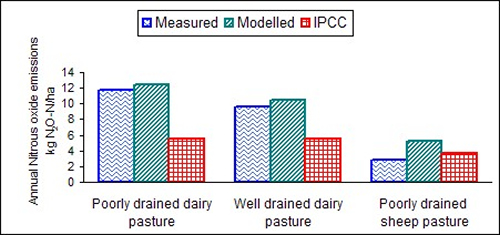Modelling nitrous oxide emissions

Model includes seasonal variations in pasture growth and N uptake rates.
Issues
- New Zealand differs from most other countries in having a greenhouse gas emissions profile dominated by the agricultural trace gases, methane and nitrous oxide. But there is a large uncertainty ( 65%) in New Zealand's N2O emissions. This uncertainty must be reduced if changes are to be reported internationally.
- Under the United Nations Framework Convention on Climate Change (UNFCCC), New Zealand is required to produce an annual inventory of N2O emissions from all anthropogenic sources to assess the magnitude and change in total emissions since 1990. New Zealand has also ratified the Kyoto Protocol, therefore committing to reducing greenhouse gas emissions to 1990 levels.
- New Zealand currently relies on Intergovernmental Panel on Climate Change (IPCC) methodology (New Zealand Climate Change Project 2003) and on animal population statistics to estimate its N2O emissions inventory.
- IPCC methodology is too simplistic and generalised as it ignores site-specfic controls, and this methodology is also not sufficiently flexible to allow mitigation options to be assessed.
- New Zealand requires a more robust, process-based approach to emissions estimates that is internationally acceptable and quantifies N2O emissions at the field level more accurately than is possible using IPCC methodology.
- Such an approach is needed to develop regional- and national-scale inventories with known levels of uncertainties, and provide a sound basis for policy making for greenhouse gas abatement or environmental protection both nationally and globally.
- New Zealand is to take action as part of concerted international effort to reduce the extent and impacts of climate change.
Approach
DNDC (DeNitrification DeComposition; Li et al. 1992) is a process-based model with reasonable data requirements that has been used to produce regional estimates for the US, China, Germany, Canada, and the UK. Although the model is suitable for simulation at appropriate temporal and spatial scales there are particular limitations in applying this model directly to New Zealand pastoral soils and climatic conditions.
We have therefore modified the DNDC model to represent New Zealand grazed pastoral systems (Saggar et al. 2004).
Modifications include:
- Pasture growth - A multiplicative day length factor was introduced to account for the seasonal variations in pasture growth and N uptake rates.
- Soil infiltration and drainage - Drainage was followed by infiltration to achieve a much better correspondence with measured soil moisture.
- Air-soil temperature relationship - T surface = T air + 1.3
- WFPS-denitrification threshold - Field capacity was used a trigger point for the production of N2O, in place of the original threshold of 35% WFPS.
The modified model, hereafter named "NZ-DNDC", was used to estimate N2O emissions from two ungrazed and grazed dairy farms and a sheep farm.
Findings
Seasonality of N2O fluxes
- N2O emissions for the grazed areas in winter were higher than those in spring. Emissions were lower in autumn and summer.
- The lowest emissions were obtained during the periods when soil water content was below field capacity.
- Large fluxes were generally observed after each grazing and rainfall event, and were followed by a decline.

Comparisons of daily measured and modelled emissions
NZ-DNDC simulated well the average daily N2O fluxes from the pastures. However, it slightly overestimated spring emissions, underestimated the very high emissions observed in summer due to high temperature and moisture after a rainfall event, but simulated well the following low emissions that dropped quickly as the soils dried out.

Comparisons of measured annual emissions with estimates from NZ-DNDC and IPCC approaches
The NZ-DNDC modelled annual emissions from both the dairy farms and a sheep farm were within the uncertainty range of the measured emissions. The model was able to pick up the differences in emissions resulting from the differences in soil texture and differences in grazing regime. The IPCC approach cannot pick up such differences.

Take-home messages
- Measured and model estimates show Emission Factors (EFs) are different for dairy and sheep-grazed systems and suggest that one EF for all as used in the current inventory (IPCC approach) will not give accurate emission estimates.
- The overall comparisons of predicted and measured annual emissions indicate NZ-DNDC should be applicable to the simulation of N2O emissions from a range of grazed pastures.
Current research
- Upscaling to regional and national scales, based on available climatic data, soil types, and numbers and types of grazing animals and their excretal N inputs.
- Review and refinement of the soil moisture sub-model to adequately represent the soil water balance and evapotranspiration from grazed pastures.
- Development of a farm-scale N2O emission model for use by farmers.
- Expansion of the application of NZ-DNDC to monitor the efficacy of mitigating urine-induced N2O emissions from grazed pasture systems, using nitrification inhibitors and other abatement strategies.
